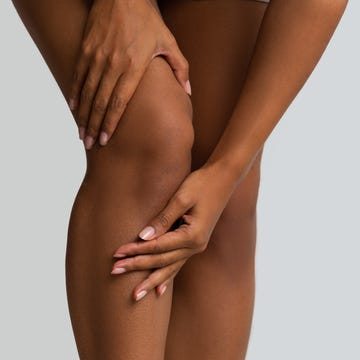I hear them invoked over and over as the root cause of everything – from low mood to poor sleep, from spots to a random itch, an intense headache, how alluring we appear to the world, or how reclusive we feel from it. Our worst tempers, our weirdest outbursts, our joys and sorrows (the full range of our emotional responses, actually), our excessive sweating, sudden changes in smell, pregnancy, infertility, periods – and the end of them – hormones are the cause of it all. They’re like a bunch of unknowable Greek Gods, buffeting our bodies and emotions around, according to their will.
But where do they come from? And how do they work? Are we born with them? Do they lurk in our children’s bodies, waiting for puberty to wake them up? Above all else, I think: how responsible are they for our characters? Our personalities? Do hormones make us who we are? More, or less, emotional? Or anxious? Or angry?
I first hear of Dr Nicky Keay after finding a paper she wrote on stress fractures in female athletes and ballet dancers whose periods had stopped because of undereating and overtraining. I google Keay and discover she’s a trained doctor, a lecturer in hormones at University College London and an advisor to dance companies, working closely with dancers to study their menstrual cycles and the impact they have on their performance. She’s also the author of Hormones, Health and Human Potential, published in 2022, and Myths of Menopause, 2024. I email her and ask if she’d meet. She says yes – “Always happy to talk hormones!” – and invites me to her home in south London for coffee.
What to read next
I ask her what a hormone is. “It’s a molecule that travels around in your bloodstream. The word comes from ancient Greek; it means: ‘setting in motion’. What’s it setting in motion? Your DNA. Your blueprint for life.”
DNA, or deoxyribonucleic acid, holds the instructions for building and running our bodies. It is made of two linked strands that wind around each other to resemble a twisted ladder – a shape known as a double helix. Hormones tell our cells which part of the DNA to read and how to put those instructions to work.
What is a hormone exactly?
So, I ask, is our DNA loitering in our cells, waiting for our hormones to boot them into action? “Exactly!”
“A hormone,” says Dr Charlotte Gribbin, a doctor of aesthetics and regenerative medicine – Botox, filler, and so forth – whose work by definition brings her into contact with many women in their 40s and 50s, so is often underpinned by whatever the hell is happening with their hormones, “is produced by a gland. It causes an effect somewhere.”
You could think of hormones as a messaging system, I learn. They’re like chemical telegrams, which zip from the gland to an organ, prompting it to perform a function. It triggers the process of you growing a pair of boobs or starting your period, or prepares your body for pregnancy. Some hormones work slowly, methodically, and according to a schedule. They send you to sleep at night (melatonin) and wake you in the morning (cortisol). Others are more instant and are inspired by a change in your environment. Adrenaline would be an example.
The human body produces a lot of hormones, over 50 by current medical reckoning. They exist within the endocrine system, communicating with each other and moderating the quantities released at any one time in accordance with each other.
Men and women share pretty much all of them; they just produce them in greater or lesser quantities. Hormonal fluctuations are thought to be behind sleep troubles in women, which may explain why men tend to experience less insomnia.
Both men and women both produce adrenaline, as discussed; and cortisol, another stress hormone, which also comes from the adrenal glands – although some studies have shown that men have a higher baseline level of this. Cortisol is, as we’ve seen, responsible for waking you in the morning.
And incidentally, Dr Gribbin tells me the most common time of the day for both men and women to have a heart attack is between seven and eight in the morning, when cortisol peaks. Cortisol controls your body’s response to a stressful situation by increasing the sugar (glucose) in your bloodstream, on the assumption it will prove useful in a fight-or-flight situation, powering muscles to punch and/or run, then managing their subsequent repair.
This is fabulous if you are in a fight-or-flight situation, but not so great if you’re not – if your stress is related to, say, a relentless onslaught of emails, road rage or undernourishing your body for an extended period of time in a misguided, desperate attempt to lose weight, because there’s a party or you want to have a beach body. And of course you know intellectually your self-worth should not be even fleetingly associated with your dress size, but you’ve got millennia of cultural expectation to overturn before you feel that instinctually – and a crash diet will be quicker.
And yet, according to Dr Keay, cortisol is the reason extreme diets don’t work. If you allow your calorific intake to drop suddenly and sharply with one of those diets, your body will respond by increasing cortisol, which – oh, irony! – encourages it to store fat in the assumption that you’re in some sort of emergency situation. A famine, perhaps. Cortisol-related weight gain tends to result in fat lodged around your abdomen, your stomach, waist, lower back – and in you weighing more than you did, before you started the crash diet.
Oxytocin is the cuddler’s hormone, the warm and fuzzy hormone, the bonder, the lover; it’s released into the blood-stream by the hypothalamus – a big daddy of a gland, a hormonal overlord situated in your brain – in response to anything from breastfeeding your newborn baby, to stroking a dog, to having an orgasm. Oxytocin literally makes you warm, too – it’s involved in the thermoregulation of your body, which is, presumably, why we associate it with emotional warmth.
Insulin is produced in the pancreas – the six-inch section of your digestive system located in your upper abdomen, behind the stomach – and regulates how effectively your cells use the glucose in your bloodstream, which is why a lack of it, or an inability to use it well, is associated with type 1 and type 2 diabetes.
T3 (triiodothyronine) and T4 (thyroxine) are two of the main hormones related to the thyroid – the butterfly-shaped glad that lies against and wraps around your windpipe. T3 and T4 are responsible for regulating your metabolism, your digestive processes, your hunger and your related energy levels.
Melatonin, like cortisol, is essential to your cycle of sleeping and waking, also known as your circadian rhythm. Melatonin originates in the pineal gland, which is located deep in the brain. It’s activated at night by a depletion in sunlight, which is why you get sleepy after dark, and it’s at its lowest levels in your body in the morning, when cortisol is at its highest. NB: blue light emitted by laptops, smartphones and tablets had, until recently, been widely assumed to suppress melatonin, and in turn, disrupt sleep. However, a new review published in 2024 in the journal Sleep Medicine Reviews, concluded this is probably not the case; it’s more likely that being deeply absorbed by whatever it is we’re scrolling through, and thus neglecting to focus on falling asleep, is what’s actually causing the disruption.
Then come the sex hormones, the steroid hormones – oestrogen, progesterone and testosterone – which don’t bother your body much until it hits puberty.
Dr Gribbin explains that hormones are different from neurotransmitters – like dopamine and serotonin. Neurotransmitters are chemicals released between nerve cells in the brain.
“Hormones talk to each other. Like, if you have too much dopamine, it’s not going to go back to your brain and say: ‘I have enough now, don’t produce anymore’. Whereas, if you have enough oestrogen, that’s going to feedback and say: ‘Stop now. I need you to cool it for a while.’”
Whatever else it does, your body is constantly working away in the background, beyond your consciousness, ensuring you’re neither too hot, nor too cold, too thirsty, or overhydrated. Hormones are part of that system. That’s so clever.
“Oh, hormones are very clever,” says Dr Keay. “There are whole families of them! An orchestra is how I describe them, imagine the strings, the woodwind – they’re all in there, in their little group. Overall, they make a whole symphony.”
How The Female Body Works (In All Its Wild And Miraculous Glory) by Polly Vernon is out now













